Apple A1143 802.11 a/b/g/n Access Point User Manual Manual
Apple Inc. 802.11 a/b/g/n Access Point Manual
Apple >
Contents
- 1. Manual
- 2. Revised Manual
Manual

AirPort Extreme
Setup Guide

2
Contents
3Chapter 1: Getting Started
11 Chapter 2: AirPort Extreme Networks
12
Using AirPort Extreme with Your Broadband Internet Service
14
Using AirPort Extreme to Share a USB Printer
16
Using AirPort Extreme to Share a USB Hard Disk
18
Using AirPort Extreme with Your AirPort Network
20 Chapter 3: Setting Up AirPort Extreme
25 Chapter 4: Tips and Troubleshooting
33 Chapter 5: Learning More, Service, and Support
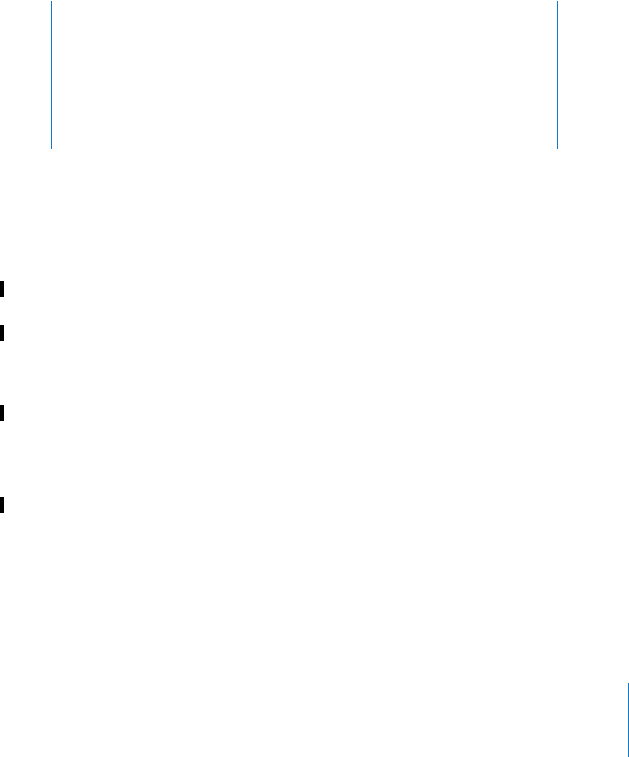
1
3
1
Getting Started
Congratulations on purchasing AirPort Extreme. Read this
guide to get started using it.
AirPort Extreme is based on the Institute of Electrical and Electronics Engineers (IEEE)
draft 802.11n standard, the fastest wireless standard, which provides better
performance and greater range than previous IEEE 802.11 standards. AirPort Extreme is
compatible with computers using 802.11b and 802.11g, as well as computers using the
802.11a wireless standards.
With AirPort Extreme, you can:
Â
Create a wireless network in your home, and then connect to the Internet and share
the connection with multiple computers simultaneously. An entire family or office
can be connected to the Internet at the same time.
Â
Connect AirPort Extreme to your Ethernet network. Wireless-equipped Macintosh
computers or Windows XP computers can access an entire network without being
connected by a cable.
Â
Connect a USB printer to your AirPort Extreme. All of the compatible computers on
the AirPort network, both wireless and wired, can print to it.

4 Chapter 1
Getting Started
Â
Connect a USB hard disk to your AirPort Extreme. All of the compatible computers on
the AirPort network, both wireless and wired, can access the information on the hard
disk.
Â
Connect a USB hub to your AirPort Extreme, and then connect multiple USB devices,
such as printers or hard disks. All of the computers on the network can access those
devices.
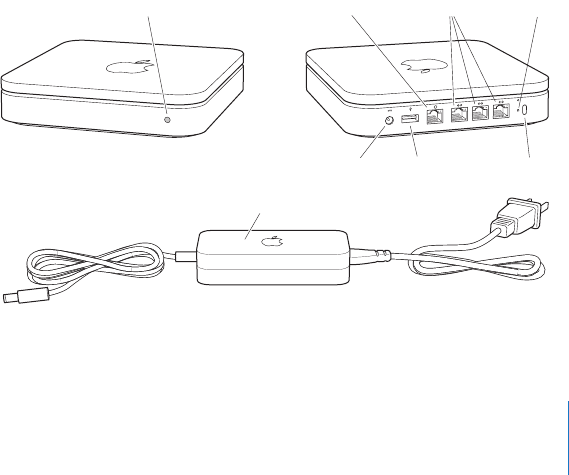
Chapter 1
Getting Started
5
About AirPort Extreme
AirPort Extreme has five ports, located on the back side:
Â
One Ethernet Wide Area Network (WAN) port (<
) for connecting a DSL or cable
modem, or for connecting to an existing Ethernet network
Â
Three 10/100 Ethernet Local Area Network (LAN) ports (G
) for connecting Ethernet
devices, such as printers or computers, or for connecting to an existing Ethernet
network
Â
One USB port (d
) for connecting a compatible USB printer, hard disk, or hub
Next to the ports is a reset button, which is used for troubleshooting your AirPort
Extreme. The status light on the front of AirPort Extreme shows the current status.
Status light Internet WAN port
AC adapter
Power port USB port
Ethernet ports Reset button
Security slot

6 Chapter 1
Getting Started
About the AirPort Software
AirPort Extreme works with the AirPort software included on the AirPort Extreme CD.
AirPort Utility
AirPort Utility helps you set up your AirPort Extreme to create a wireless network,
connect to the Internet, and share a USB printer or hard disk. You can also connect
your AirPort Extreme to your existing AirPort Extreme or AirPort Extreme wireless
network to extend the range of your network using a Wireless Distribution System
(WDS). Use the setup assistant in AirPort Utility to quickly and easily set up your
AirPort Extreme and your wireless network.
AirPort Utility is also an advanced tool for setting up and managing AirPort Extreme
and AirPort Express Base Stations. Use AirPort Utility to adjust network, routing, and
security settings and other advanced options.
Z
AirPort status menu in the menu bar
Use the AirPort status menu to switch quickly between AirPort networks, monitor
the signal quality of the current network, create a computer-to-computer network,
and turn AirPort on and off. The status menu is available on computers using
Mac OS X.
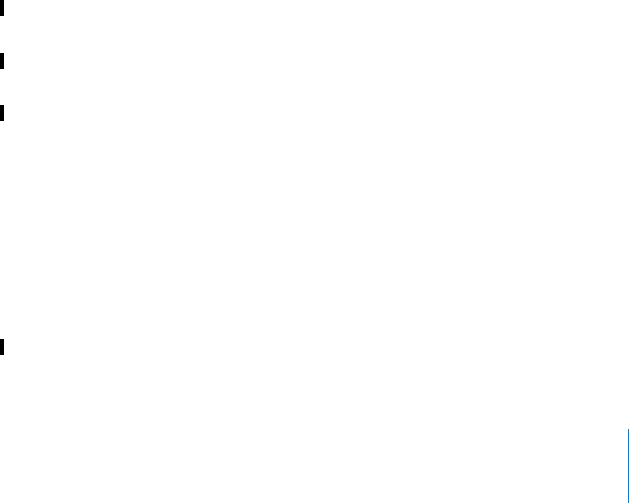
Chapter 1
Getting Started
7
What You Need to Get Started
To set up AirPort Extreme using a Macintosh, you must have the following:
Â
A Macintosh computer with an AirPort or AirPort Extreme Card installed to set it up
wirelessly
Â
A Macintosh computer connected to AirPort Extreme with an Ethernet cable to set it
up using Ethernet
Â
Mac OS X v10.4 or later
Â
AirPort Utility 5 or later
To set up AirPort Extreme using a Windows PC, you must have the following:
Â
A Windows PC with 300-MHz or higher processor speed
Â
Windows XP Home or Professional (with Service Pack 2 installed)
Â
AirPort Utility 5 or later
You can use AirPort Extreme with any wireless-enabled computer that is compliant
with the IEEE 802.11a, 802.11b, 802.11g standards, or with draft 802.11n. To set up AirPort
Extreme, your computer must meet the requirements listed above.
Install the AirPort software that came on the CD and follow the instructions on the
following pages to set up your AirPort Extreme and your AirPort wireless network.
Plugging In AirPort Extreme
Before you plug in your AirPort Extreme, first connect the appropriate cables to the
ports you want to use, including:
Â
An Ethernet cable connected to your DSL or cable modem (if you will connect to the
Internet) to the Ethernet (WAN) port (<
)

8 Chapter 1
Getting Started
Â
A USB cable to the USB port (d
) and to a compatible USB printer (if you will print to a
USB printer), a USB hard disk, or USB hub
Â
Any Ethernet devices to the Ethernet LAN (G
) ports
After you have connected the cables for all the devices you plan to use, connect the AC
plug adapter, and plug AirPort Extreme into the wall. There is no “on” switch.
Important:
Use only the AC adapter that came with your AirPort Extreme.
When you plug AirPort Extreme into the wall, the status light flashes green for one
second, and then glows amber while it starts up. After it has started up completely, the
status light glows solid green.
Power port Ethernet activity light
AC adapter
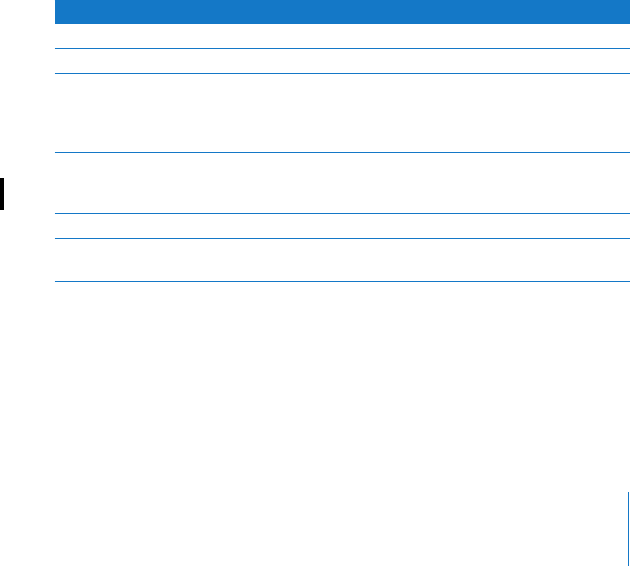
Chapter 1
Getting Started
9
When you connect Ethernet cables to the Ethernet LAN (G
) ports, the lights above the
ports blink when there is network activity.
AirPort Extreme Status Lights
The following table explains AirPort Extreme light sequences and what they indicate.
What’s Next
After you plug in AirPort Extreme, use the setup assistant in AirPort Utility to set it up
to work with your Internet connection, USB printer or hard disk, or an existing network.
The AirPort Utility is located in the Utilities folder in the Applications folder on a
Macintosh, and in Start > All Programs > AirPort on a computer using Windows XP.
See “AirPort Extreme Networks” on page 11 for examples of all the ways you can use
AirPort Extreme, and information about how to set it up.
Light Status/description
Off
AirPort Extreme is unplugged.
Flashing green
AirPort Extreme is starting up. The light flashes for one second.
Solid green
AirPort Extreme is on and working properly. If you choose Flash
On Activity from the Status Light pop-up menu (on the Base
Station pane of AirPort settings in AirPort Utility), the status light
may flash green to indicate normal activity.
Flashing amber
AirPort Extreme cannot establish a connection to the network or
the Internet. See “Your AirPort Extreme Status Light Flashes
Amber” on page 28.
Solid amber
AirPort Extreme is completing its startup sequence.
Flashing amber and green
There may be a problem starting up. AirPort Extreme will restart
and try again.

10 Chapter 1
Getting Started
See “Setting Up AirPort Extreme” on page 20 to find out more about using AirPort
Utility to set up your base station and wireless network.

2
11
2
AirPort Extreme Networks
In this chapter you’ll find explanations of the different ways
you can use AirPort Extreme.
This chapter gives examples of the different kinds of networks you can set up using
AirPort Extreme. It provides diagrams and explanations of what you need to do to get
your AirPort Extreme network up and running quickly.
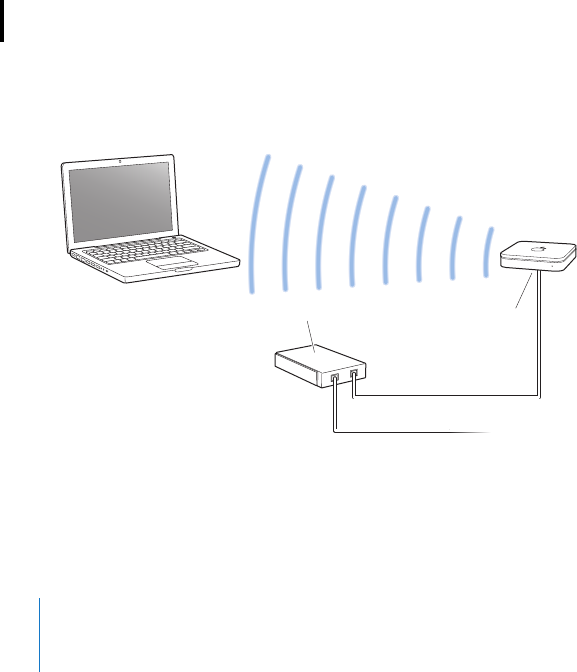
12 Chapter 2
AirPort Extreme Networks
Using AirPort Extreme with Your Broadband Internet Service
When you set up AirPort Extreme to provide network and Internet access, Macintosh
computers with AirPort and AirPort Extreme Cards, and 802.11b, 802.11g, and 802.11n
wireless-equipped computers can access the wireless AirPort network to share files,
play games, and use Internet applications like web browsers and email applications.
It looks like this:
DSL or cable modem Internet WAN port
to Internet
<
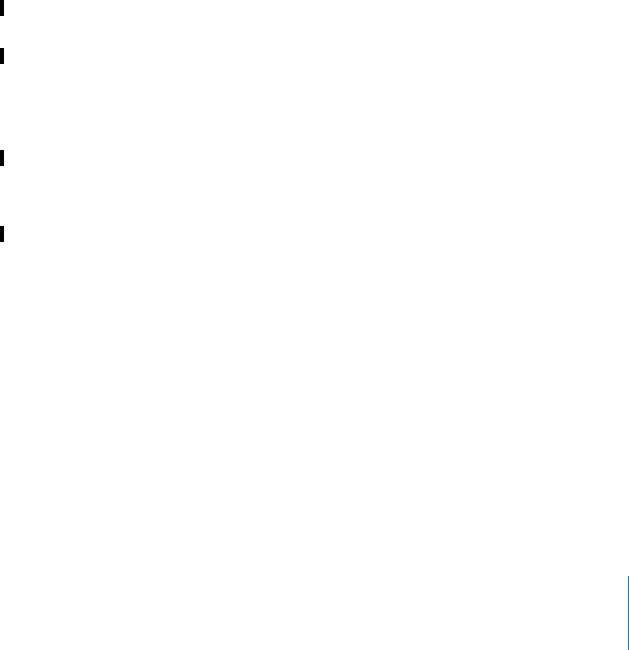
Chapter 2
AirPort Extreme Networks
13
To set it up:
1
Connect your DSL or cable modem to your AirPort Extreme Ethernet WAN (<
) port.
2
Open AirPort Utility (located in the Utilities folder in the Applications folder), select
your base station, and then click Continue.
3
Follow the onscreen instructions to create a new network or join an existing one. (See
“Setting Up AirPort Extreme” on page 20.)
Computers using AirPort and computers using other wireless cards or adapters connect
to the Internet through AirPort Extreme. Computers connected to AirPort Extreme
Ethernet ports can also access the network and connect to the Internet.
Wireless computers and computers connected to the Ethernet ports can also
communicate with one another through AirPort Extreme.

14 Chapter 2
AirPort Extreme Networks
Using AirPort Extreme to Share a USB Printer
When you connect a USB printer to your AirPort Extreme, all computers on the network
(wired and wireless) can print to it.
It looks like this:
USB port
Shared printer
d

Chapter 2
AirPort Extreme Networks
15
To set it up:
1
Connect the printer to the AirPort Extreme USB port (d
) using a USB cable.
2
Open AirPort Utility (located in the Utilities folder in the Applications folder), select
your base station, and then click Continue.
3
Follow the onscreen instructions to create a new network.
To use the printer connected toa computer using Mac OS X v10.2.7 or later:
1
Open Printer Setup Utility (located in the Utilities folder in the Applications folder).
2
Select the printer from the list.
If the printer is not in the list, click Add, choose Bonjour from the pop-up menu, and
then select the printer from the list.
To use the printer connected to a computer using or Windows XP:
1
Install Bonjour for Windows from the CD that came with your AirPort Extreme.
2
Follow the onscreen instructions to connect your printer.
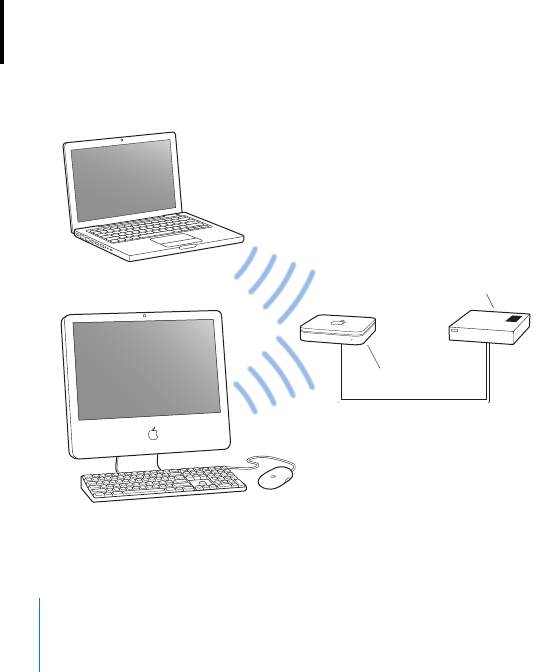
16 Chapter 2
AirPort Extreme Networks
Using AirPort Extreme to Share a USB Hard Disk
When you connect a USB hard disk to your AirPort Extreme, all computers on the
network (wired and wireless) can connect to the hard disk to access, share, and store
files.
It looks like this:
Shared hard disk drive
USB port
d

Chapter 2
AirPort Extreme Networks
17
To set it up:
1
Connect the hard disk to the AirPort Extreme USB port (d
) using a USB cable.
2
Open AirPort Utility (located in the Utilities folder in the Applications folder), select
your base station, and then click Continue.
3
Follow the onscreen instructions to create a new network.
Computers can access the hard disk to share or store files using Mac OS X v10.4 or later,
or Windows XP (with Service Pack 2).
To access the hard disk from a computer using Mac OS X:
1
From the Finder, choose Go > Connect to Server.
2
Click Browse, select the name of your base station, and then click Connect.
3
Select Guest to connect to the hard disk.
To access the hard disk from a computer using Windows XP:
1
Right-click on My Computer and choose Map Network Disk.
2
Enter the base station’s IP address and share name.

18 Chapter 2
AirPort Extreme Networks
Using AirPort Extreme with Your AirPort Network
The illustration below shows a wireless network utilizing all the capabilities of AirPort
Extreme.
DSL or cable modem
to USB port
to USB port
USB hub to Internet
to Ethernet
port
AirPort Extreme
Shared hard
disk drive
Shared
printer

Chapter 2
AirPort Extreme Networks
19
To set it up
1
Connect all the devices you plan to use in your network.
2
Open AirPort Utility (located in the Utilities folder in the Applications folder), select
your base station, and then click Continue.
3
Follow the onscreen instructions to set up your network. (See “Setting Up AirPort
Extreme” on page 20.)

3
20
3
Setting Up AirPort Extreme
This chapter provides information and instructions for using
AirPort Utility to set up your AirPort Extreme.
Use the diagrams in the previous chapter to help you decide where you want to use
your AirPort Extreme, and what features you want to set up on your AirPort network.
Then use the instructions in this chapter to easily configure AirPort Extreme and set up
your AirPort network.
This chapter provides an overview for using the setup assistant in AirPort Utility to set
up your network and other features of your AirPort Extreme. For more detailed wireless
networking information, and for information about the advanced features of AirPort
Utility and AirPort Express, refer to the “Designing AirPort Networks” document, located
on the AirPort Extreme CD and at www.apple.com/airportextreme.
You can do most of your network setup and configuration tasks using the setup
assistant in AirPort Utility. To set advanced options, choose Manual Setup from the Base
Station menu of AirPort Utility. See “Setting Advanced Options” on page 23.

Chapter 3
Setting Up AirPort Extreme
21
Using the AirPort Utility
To set up and configure your AirPort Extreme to use AirPort for wireless networking
and Internet access, use the setup assistant in AirPort Utility. AirPort Utility is installed
on your computer when you install the software on the AirPort Extreme CD.
On a Macintosh computer using Mac OS X v10.3 or later:
1
Open AirPort Utility, located in the Utilities folder in your Applications folder.
2
Select your base station, and then click Continue.
3
Follow the onscreen instructions to set up your AirPort Extreme and your wireless
network.
On a computer using Windows XP (with Service Pack 2):
1Open AirPort Utility, located in Start > All Programs > AirPort.
2Select your base station, and then click Continue.
3Follow the onscreen instructions to set up your AirPort Extreme and your wireless
network.

22 Chapter 3 Setting Up AirPort Extreme
The setup assistant in AirPort Utility asks you a series of questions about the type of
network you want to use and the services you want to set up. The setup assistant helps
you enter the appropriate settings for the network you are setting up.
If you are using AirPort Extreme to connect to the Internet, you need a broadband (DSL
or cable modem) account with an Internet service provider, or a connection to the
Internet using an existing Ethernet network. If you received specific information from
your ISP (such as a static IP address or a DHCP client ID), you may need to enter it in
AirPort Utility. Have this information available before you set up your AirPort Extreme.
Creating a New Wireless Network
You can use the setup assistant in AirPort Utility to create a new wireless network. The
setup assistant guides you through the steps necessary to name your network, protect
your network with a password, and set other options.
If you plan to share a USB printer or USB hard disk on your network:
1Connect the printer or hard disk to the AirPort Extreme USB port (d).
2Open AirPort Utility, located in Utilities folder in the Applications folder on a Macintosh,
or in Start > All Programs > AirPort on a computer using Windows XP.
3Follow the onscreen instructions to create a new network.
Configuring and Sharing Internet Access
If you plan to share your Internet connection with wireless-enabled computers on your
network or computers connected to the Ethernet ports, you need to set up your
AirPort Extreme as an AirPort Base Station. After it is set up, computers access the
Internet via the AirPort network. The base station connects to the Internet and
transmits information to the computers over the AirPort network.

Chapter 3 Setting Up AirPort Extreme 23
Before you use the AirPort Utility to set up your base station, connect your DSL or cable
modem to the AirPort Extreme Ethernet WAN port (<). If you are using an existing
Ethernet network with Internet access to connect to the Internet, you can connect the
AirPort Extreme to the Ethernet network instead.
Use the setup assistant in AirPort Utility to enter your ISP settings and configure how
AirPort Extreme shares the settings with other computers.
1Open AirPort Utility, located in Utilities folder in the Applications folder on a Macintosh,
or in Start > All Programs > AirPort on a computer using Windows XP.
2Select your base station, and then click Continue.
3Follow the onscreen instructions to configure and share Internet access on your AirPort
Extreme.
Using the setup assistant in AirPort Utility is a quick and easy way to set up your base
station and network. If you want to set additional options for your network, such as
restricting access to your network, or setting advanced DHCP options, you can choose
Manual Setup from the Base Station menu of AirPort Utility. See “Setting Advanced
Options” on page 23.
Setting Advanced Options
To set advanced options, you can use AirPort Utility to set up your AirPort Extreme
manually. You can configure advanced base station settings, such as advanced security
options, closed networks, DHCP lease time, access control, power controls, setting up
user accounts, and more.

24 Chapter 3 Setting Up AirPort Extreme
To set advanced options:
1Choose the wireless network you want to change. On a Macintosh, use the AirPort
status menu in the menu bar. On a computer using Windows XP, hold the pointer over
the wireless connection icon until you see your AirPort network name (SSID), and
choose it from the list if there are multiple networks available.
2Open AirPort Utility, located in the Utilities folder in the Applications folder on a
Macintosh, and in Start > All Programs > AirPort on a computer using Windows XP.
3If there is more than one base station in the list, select the base station you want to
configure. If you don’t see the base station you want to configure, click Rescan to scan
for available base stations, and then select the base station you want.
4Choose Manual Setup from the Base Station menu. If you are prompted for a password,
enter it.
For more information and detailed instructions for using the manual setup features in
AirPort Utility, see the “Designing AirPort Networks” document, located on your AirPort
Extreme CD and at www.apple.com/airport.

4
25
4Tips and Troubleshooting
You can quickly solve most problems with AirPort Extreme by
following the advice in this chapter.
The AirPort Software Can’t Detect the Proper AirPort Hardware
Make sure that the computer you are using has an AirPort Card or an AirPort Extreme
Card installed. If you recently installed the card, shut down your computer and make
sure the card is properly installed. Make sure that the AirPort antenna is securely
connected to the card (you should hear a click when the antenna is connected
securely). Make sure that the other end of the card is firmly inserted into the connector
in the AirPort Card slot.
If you are using a computer with Windows XP, make sure the wireless card or adapter is
installed correctly. See the documentation that came with your computer to check the
connection if you are using a computer with Windows XP. Also make sure you have
installed Service Pack 2.

26 Chapter 4 Tips and Troubleshooting
You Forgot Your Network or AirPort Extreme Password
You can clear the AirPort network or base station password by resetting AirPort
Extreme.
To reset the base station password:
1Use the end of a straightened paper clip to press and hold the reset button for one
second.
2Select your AirPort network.
ÂOn a Macintosh, use the AirPort status menu in the menu bar to select the network
created by AirPort Extreme (the network name does not change).
ÂOn a computer using Windows XP, hold the pointer over the wireless connection icon
until you see your AirPort Network Name (SSID), and choose it from the list if there
are multiple networks available.
3Open AirPort Utility (in the Utilities folder in the Applications folder on a Macintosh,
and in Start > All Programs > AirPort on a computer using Windows XP).
4Select your base station and then choose Manual Setup from the View menu.
5Click AirPort in the toolbar, and then click Base Station.
6Enter a new password for the base station.
7Click Wireless and choose an encryption method from the Wireless Security pop-up
menu to turn on encryption and activate password protection for your AirPort network.
If you turn on encryption, enter a new password for your AirPort network.
8Click Update to restart the base station and load the new settings.

Chapter 4 Tips and Troubleshooting 27
Your AirPort Extreme Isn’t Responding
Try unplugging it and plugging it back into a power outlet.
If your AirPort Extreme stops responding completely, you may need to reset it to the
factory default settings. This erases all of the settings you’ve made and resets them to
the settings that came with the AirPort Extreme.
To return AirPort Extreme to the factory settings:
mUse the end of a straightened paper clip to press and hold the reset button until the
status light flashes quickly (about 5 seconds).
AirPort Extreme resets with the following settings:
ÂAirPort Extreme receives its IP address using DHCP.
ÂThe network name reverts to Apple Network XXXXXX (where X is a letter or number).
ÂThe AirPort Extreme password returns to public.
If your base station is still not responding, try the following:
1Unplug AirPort Extreme.
2Use the end of a straightened paper clip to hold down the reset button while you plug
in AirPort Extreme.

28 Chapter 4 Tips and Troubleshooting
Your AirPort Extreme Status Light Flashes Amber
The Ethernet cable may not be connected properly, AirPort Extreme may be out of
range of an AirPort network, or there may be a problem with your Internet service
provider. If you are connected to the Internet with a DSL or cable modem, the modem
may have lost its connection to the network or the Internet. Even if the modem seems
to be working properly, try disconnecting the modem from its power supply, waiting a
few seconds, and then reconnecting it. Make sure AirPort Extreme is connected directly
to the modem via Ethernet before reconnecting power to the modem.
For more information on the reason the light flashes, open AirPort Utility, select your
base station, and then choose Manual Setup from the View menu. The information
about the flashing light is displayed in the Summary pane.
Your Printer Isn’t Responding
If you connected a printer to the USB port on your AirPort Extreme and the computers
on the AirPort network can’t print, try the following:
1Make sure the printer is plugged in and turned on.
2Make sure the cables are securely connected to the printer and to the AirPort Extreme
USB port.

Chapter 4 Tips and Troubleshooting 29
3Make sure the printer is selected in the Printer List window on client computers. To do
this on a Macintosh using Mac OS X v10.3 or later:
ÂOpen Printer Setup Utility, located in the Utilities folder in the Applications folder.
ÂIf the printer is not in the list, click Add.
ÂChoose Bonjour from the pop-up menu.
ÂSelect the printer, and then click Add.
To select your printer on a computer using Windows XP:
ÂOpen “Printers and Faxes” from the Start menu.
ÂSelect the printer. If the printer is not in the list, click Add Printer and then follow the
onscreen instructions.
4Turn off the printer, wait a few seconds, and then turn it on again.
I Want to Update My AirPort Software
Apple periodically updates AirPort software to improve performance or add features.
It is recommended that you update your AirPort Extreme to use the latest software. To
download the latest version of AirPort software, go to
www.support.apple.com/airport.

30 Chapter 4 Tips and Troubleshooting
AirPort Extreme Placement Considerations
The following recommendations can help your AirPort Extreme achieve maximum
wireless range and optimal network coverage.
ÂPlace your AirPort Extreme in an open area where there are few obstructions, such as
large pieces of furniture or walls. Try to place it away from metallic surfaces.
ÂIf you place your AirPort Extreme behind furniture, keep at least at least an inch of
space between the AirPort Extreme and the edge of the furniture.
ÂAvoid placing your AirPort Extreme in areas surrounded by metal surfaces on
three or more sides.
ÂIf you place your AirPort Extreme in an entertainment center with your stereo
equipment, avoid completely surrounding AirPort Extreme with audio, video, or
power cables. Place your AirPort Extreme so that the cables are to one side. Maintain
as much space as possible between AirPort Extreme and the cables.
ÂTry to place your AirPort Extreme at least 25 feet from a microwave oven and 2.4 or 5
GHz cordless phones, or other sources of interference.
Items That Can Cause Interference with AirPort
The farther away the interference source, the less likely it is to cause a problem. The
following items can cause interference with AirPort communication:
ÂMicrowave ovens
ÂDirect Satellite Service (DSS) radio frequency leakage
ÂThe original coaxial cable that came with certain types of satellite dishes. Contact the
device manufacturer and obtain newer cables.

Chapter 4 Tips and Troubleshooting 31
ÂCertain electrical devices such as power lines, electrical railroad tracks, and power
stations
ÂCordless telephones that operate in the 2.4 or 5 gigahertz (GHz) range. If you have
problems with your phone or AirPort communication, change the channel your base
station or AirPort Extreme uses, or change the channel your phone uses.
ÂNearby base stations using adjacent channels. For example, if base station A is set to
channel 1, base station B should be set to channel 6 or higher.

5
33
5Learning More,
Service, and Support
You can find more information about using AirPort Extreme on
your hard disk, on the web, and in onscreen help.
Online Resources
For the latest information on AirPort Extreme, go to www.apple.com/airport.
To register AirPort Extreme (if you didn’t do so when you installed the software on the
AirPort Extreme CD), go to www.apple.com/register.
For AirPort service and support information, a variety of forums with product-specific
information and feedback, and the latest Apple software downloads, go to
www.apple.com/support/airport.
For support outside of the United States, go to www.apple.com/support, and then
choose your country from the pop-up menu.

34 Chapter 5 Learning More, Service, and Support
Onscreen Help
mTo learn more about using AirPort, open AirPort Utility and choose Help > AirPort Help.
Obtaining Warranty Service
If the product appears to be damaged or does not function properly, please follow the
advice in this booklet, the onscreen help, and the online resources.
If the base station still does not function, go to www.apple.com/support for
instructions about how to obtain warranty service.
Finding the Serial Number of Your AirPort Extreme
The serial number is printed on the bottom of your AirPort Extreme.

35
Appendix
AirPort Extreme Specifications
AirPort Specifications
ÂWireless Data Rate: Up to 54 megabits per second (Mbps)
ÂRange: Up to 150 feet (45 meters) in typical use (varies with environment)
ÂFrequency Band: 2.4 and 5 gigahertz (GHz)
ÂRadio Output Power: 15 dBm (nominal)
ÂStandards: 802.11 DSSS 1 and 2 Mbps standard, 802.11b, 802.11g, 802.11a, and draft
802.11n specifications
Interfaces
ÂRJ-45 Ethernet LAN connector for built-in 10/100Base-T (G)
ÂUniversal Serial Bus (USB) printing (d)
ÂAirPort Extreme
Environmental Specifications
ÂOperating Temperature: 32° F to 95° F (0° C to 35° C)
ÂStorage Temperature: –13° F to 140° F (–25° C to 60° C)
ÂRelative Humidity (Operational): 20% to 80% relative humidity
ÂRelative Humidity (Storage): 10% to 90% relative humidity, noncondensing
Size and Weight
ÂHeight: 6.50 inches (165.0mm)

36 Appendix AirPort Extreme Specifications
ÂWidth: 6.50 inches (165.0mm)
ÂThickness: 1.34 inches (34.0mm)
ÂWeight: 1.66 pounds (753 grams)
Hardware Addresses
The AirPort Extreme has two hardware addresses printed on the bottom of the case:
ÂAirPort ID: The address used to identify AirPort Extreme on a wireless network.
ÂEthernet ID: This also known as the MAC address. You may need to provide this
address to your ISP to connect AirPort Extreme to the Internet.
Using AirPort Extreme
ÂThe only way to shut off power completely to your AirPort Extreme is to disconnect it
from the power source.
ÂWhen connecting or disconnecting your AirPort Extreme, always hold it by its sides.
Keep fingers away from the metal part of the plug.
ÂYour AirPort Extreme is a high-voltage component and should not be opened for any
reason, even when the AirPort Extreme is unplugged. If your AirPort Extreme needs
service, see “Learning More, Service, and Support” on page 33.
ÂNever force a connector into the ports. If the connector and port do not join with
reasonable ease, they probably don’t match. Make sure that the connector matches
the port and that you have positioned the connector correctly in relation to the port.

Appendix AirPort Extreme Specifications 37
About Operating and Storage Temperatures
When you are using your AirPort Extreme, it is normal for the case to get warm. The
AirPort Extreme case functions as a cooling surface that transfers heat from inside the
unit to the cooler air outside.
Avoid Wet Locations
ÂKeep AirPort Extreme away from sources of liquids, such as drinks, washbasins,
bathtubs, shower stalls, and so on.
ÂProtect AirPort Extreme from direct sunlight and rain or other moisture.
ÂTake care not to spill any food or liquid on your AirPort Extreme. If you do, unplug
AirPort Extreme before cleaning up the spill.
ÂDo not use AirPort Extreme outdoors. AirPort Extreme is an indoor product.
Do Not Make Repairs Yourself
About Handling
Your AirPort Extreme may be damaged by improper storage or handling. Be careful not
to drop your AirPort Extreme when transporting the device.
Warning: To reduce the chance of shock or injury, do not use your AirPort Extreme in
or near water or wet locations.
Warning: Do not attempt to open your AirPort Extreme or disassemble it. You run
the risk of electric shock and voiding the limited warranty. No user-serviceable parts
are inside.

39
Communications Regulation Information
FCC Declaration of Conformity
This device complies with part 15 of the FCC rules.
Operation is subject to the following two conditions: (1)
This device may not cause harmful interference, and (2)
this device must accept any interference received,
including interference that may cause undesired
operation. See instructions if interference to radio or
television reception is suspected.
Radio and Television Interference
This computer equipment generates, uses, and can
radiate radio-frequency energy. If it is not installed and
used properly—that is, in strict accordance with Apple’s
instructions—it may cause interference with radio and
television reception.
This equipment has been tested and found to comply
with the limits for a Class B digital device in accordance
with the specifications in Part 15 of FCC rules. These
specifications are designed to provide reasonable
protection against such interference in a residential
installation. However, there is no guarantee that
interference will not occur in a particular installation.
You can determine whether your computer system is
causing interference by turning it off. If the interference
stops, it was probably caused by the computer or one of
the peripheral devices.
If your computer system does cause interference to
radio or television reception, try to correct the
interference by using one or more of the following
measures:
ÂTurn the television or radio antenna until the
interference stops.
ÂMove the computer to one side or the other of the
television or radio.
ÂMove the computer farther away from the television or
radio.
ÂPlug the computer into an outlet that is on a different
circuit from the television or radio. (That is, make
certain the computer and the television or radio are on
circuits controlled by different circuit breakers or
fuses.)
If necessary, consult an Apple Authorized Service
Provider or Apple. See the service and support
information that came with your Apple product. Or,
consult an experienced radio/television technician for
additional suggestions.
Important: Changes or modifications to this product not
authorized by Apple Computer, Inc. could void the EMC
compliance and negate your authority to operate the
product.
This product was tested for FCC compliance under
conditions that included the use of Apple peripheral
devices and Apple shielded cables and connectors
between system components. It is important that you
use Apple peripheral devices and shielded cables and
connectors between system components to reduce the
possibility of causing interference to radios, television
sets, and other electronic devices. You can obtain Apple
peripheral devices and the proper shielded cables and
connectors through an Apple-authorized dealer. For
non-Apple peripheral devices, contact the manufacturer
or dealer for assistance.
Responsible party (contact for FCC matters only): Apple
Computer, Inc., Product Compliance, 1 Infinite Loop M/S
26-A, Cupertino, CA 95014-2084, 408-974-2000.

Industry Canada Statement
This Class B device meets all requirements of the
Canadian interference-causing equipment regulations.
Cet appareil numérique de la Class B respecte toutes les
exigences du Règlement sur le matériel brouilleur du
Canada.
VCCI Class B Statement
Europe — EU Declaration of Conformity
Complies with European Directives 72/23/EEC, 89/336/
EEC, 1999/5/EC. For more information, see
www.apple.com/euro/compliance.
European Union — Disposal Information
This symbol means that according to local laws and
regulations your product should be disposed of
separately from household waste. When this product
reaches its end of life, take it to a collection point
designated by local authorities. Some collection points
accept products for free. The separate collection and
recycling of your product at the time of disposal will
help conserve natural resources and ensure that it is
recycled in a manner that protects human health and
the environment.
Disposal Information
Dispose of your product according to your local
environmental laws and guidelines. For information
about Apple's recycling program, go to
www.apple.com/environment.
Deutschland
Dieses Gerät enthält Batterien. Bitte nicht in den
Hausmüll werfen. Entsorgen Sie dieses Gerätes am Ende
seines Lebenszyklusen tsprechend der maßgeblichen
gesetzlichen Regelungen.
Nederlands
Gebruikte batterijen kunnen worden ingeleverd bij de
chemokar of in een specialebatt erijcontainer voor klein
chemisch afval (kca) wordengedeponeer d.
Taiwan
www.apple.com/airport
www.apple.com/support/airport
034-3422-A
Printed in XXXX
© 2006 Apple Computer, Inc. All rights reserved.
Apple, the Apple logo, AirPort, Bonjour, iTunes, Mac,
Macintosh, and Mac OS are trademarks of Apple
Computer, Inc.,
registered in the U.S. and other countries. AirPort
Extreme, AirTunes are trademarks of Apple Computer,
Inc.

42